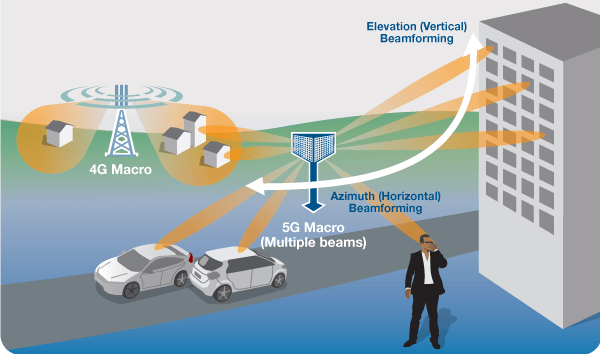5G NR wireless technology is mainly developed by 3GPP to support the first 5G applications and the new 5G ecosystem. There are many techniques currently being used to enhance 5G system performance and provide extended coverage, large capacities, and improved user experience.
5G NR wireless frequency bands
According to 3GPP, the 5G NR frequency bands are defined in Frequency Range FR1 for sub6 GHz which includes existing bands used by previous standards and Frequency Range FR2 for bands above 6 GHz including the millimeter-wave region. Sub6GHz is suitable for primary capacity and coverage layer, while millimeter-wave frequencies are more suitable for hotspot, self-backhaul, and FWA. C-band at 3.5GHz is the first band for 5G deployment, while millimeter-wave frequencies at 26/28GHz, are also defined for 5G NR use.
Millimeter-waves due to the large available bandwidth, offer high data rates and capacity, but because of the nature of these higher frequencies, the propagation is limited by extreme weather phenomena, resulting in smaller cell sizes. For this reason, 5G NR technology aims to aggregate the available bands to provide larger bandwidths, full accessibility, and take advantage of the characteristics of each different frequency to provide efficient 5G spectrum management.
5G Massive MIMO technology
MIMO (Multiple Input – Multiple Output) is a wireless technology that uses multiple transmitting and receiving antennas. Enhanced with beam-forming and diversity techniques, the antenna system provides high spectrum efficiency, delivering multiples of the radio capacity using a single radio channel.
Beam-steering is also used to change the direction of the main lobe of the radiation pattern in a multiple antenna system and steer the beam towards the desired direction. This change of direction is achieved by transmitting the same signal of each antenna with different phase-shifts.
In massive MIMO, compared to standard MIMO, the system can operate with a higher number of antennas. The same resources can be reused for multiple users within a sector, while interference can be minimized and cell capacity increased at the same time. Massive MIMO becomes more practical at high bands since antennas become physically smaller with higher frequency, and the antenna spacing distance is also reduced. Consequently, it is possible to design massive MIMO antennas in a more compact format at millimeter-wave frequencies.
The number of transmission ports can be higher than the number of MIMO streams, for example, 64 transmit ports and 16 MIMO streams. When multiple beams with different azimuth angles are used, the antennas can steer beams in a different elevation angle, and multi-user MIMO can be applied.
3D MIMO
When the antennas are all placed in a single horizontal plane, 2D beam-forming is achieved, since the elevation of angles is similar for all beams. If the system can control both elevation angle and the azimuth, with the antennas placed in different heights, 3D-MIMO is achieved. 3D-MIMO is used for steering beams both in the horizontal and vertical dimensions and can achieve the same results with massive MIMO but using fewer antennas.
For example, by enabling 3D-MIMO, we can enlarge the coverage of 3.5 GHz to 1.8GHz in 2x2TRx. This way, a more precise 3D beam is achieved to enhance the vertical signal strength that may provide 3dB coverage gain in a 64x64TRx system compared to 8x8TRx and a 9dB gain compared to 2x2TRx, resulting in a higher user SINR and better interference control.
Using narrow beams is easy to have MU beam-forming spatial multiplexing and interference control among different layers. This may further increase capacity by a factor of 8.
5G NR wireless techniques for enhanced performance
The advanced 5G wireless technology will provide a more capable air interface to improve user experience and capacity further. Wide bandwidth and massive MIMO techniques will also enhance the 5G cost-per-bit. It is expected that compared to the average 150Mbps LTE throughput, the 5G peak throughput with the aid of 64x64TRx and 100MHz channel bandwidth will reach 5Gbps capacities.
Downlink/Uplink decoupling of C-band (3.5GHz) and 1.8GHz is a critical technology to enlarge the coverage of C-band and help the operator to save site locations. UL & DL Decoupling extends 3.5GHz coverage and maximizes the value of legacy bands. Decoupling downlink from uplink will also result in higher user throughput at the same site location. NR and LTE will be sharing the low 1.8GHz band, where 1.8GHz uplink can be used as a range extender.
Enhanced SU-MU beam-forming is also expected to improve the user experience. This can be achieved by transmitting in turns SRS signals by different cell sites on a single UE at an edge cell position, providing iterative linear pre-coding and non-linear pre-coding.
Efficient scheduling and pairing algorithms via adaptive CP-OFDM and DFT-OFDM can increase the uplink capacity by a significant amount. CP-OFDM applies windowing and filtering to deliver higher spectral efficiency with comparable out-of-band emission performance and lower complexity than alternative multi-carrier waveforms under practical implementations.
Advanced low latency is another essential aspect, especially when it comes down to URLLC services. By providing shortened TTI, even down to 2 symbols 140μs compared to the fixed LTE TTI of 1ms, the next sub-frame can be transmitted faster, thus, reducing the waiting time and the overall latency.
Embedded Air Interface (EAI) is another technique for multiplexing eMBB and URLLC services by dynamically sharing the air interface resource based on service requirements.
The self-contain frame is a fast UL/DL switch to decrease the waiting time, while Grant Free Access can reduce latency by having the uplink transmission free from the grant procedure.
As described above, these advanced techniques aim to enhance the 5G user experience by providing the new 5G systems with higher throughput and extended coverage. Spectrum efficiency will also result in cost-effective spectrum management, and make 5G system investment more attractive to Telecom Operators around the globe.













